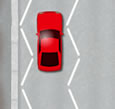Either test your luck or read through the road signs and road markings tutorials, then test yourself with the road markings quiz below. Many of the questions in the quiz will be asked during the actual driving theory test. The times at which the restrictions apply for other road markings are shown on nearby plates or on entry signs to controlled parking zones. If no days are shown on the signs, the restrictions are in force every day including Sundays and Bank Holidays.
White bay markings and upright signs (see below) indicate where parking is allowed. Are there different road signs and road markings? What are road markings?
UK road markings include those along and across the carriageway, along the edge of the carriageway, on the kerb or at the edge of the carriageway and other road markings. Ensure that you understand each road line marking in order to pass your driving theory test and to become and safe driver on the road.
Road and Line Markings Test. One-way traffic sign. Park only on Sundays and bank holidays. A large part of the theory test is based on road markings and lines knowledge and of course this knowledge is also essential when learning to drive and taking the driving test.

Markings along the edge of the road usually relate to parking and waiting rules. The most common examples feature below: Single yellow line.
Single yellow lines are found on the edges of roads and indicate that drivers should never wait on this section between the times given on nearby signs. Vehicle markings help with visibility and give information about dangerous or hazardous loads - read a list of all vehicle markings used on UK vehicles from The Highway Code.
Traffic signs The Highway Code’s ‘Traffic signs’ is for all new drivers and riders who need to pass the driving theory test. Ability to understand and be able to.
On some roads, this marking appears just before a. Other Example Illustrations. Give way to traffic on a major road - can also be used at a mini roundabout. Stop line at signals or police control. A broken white line.
A great video for learners to understand the road marking in the uk - The Th. Pavement markings with a double solid yellow center line marks a no-passing zone.
Traffic from either direction is prohibited from drive to the left of the double solid yellow line to pass other vehicles. The line may be crossed to turn into or from a driveway, private road or an alley. You may normally also cross the line when an obstruction makes it necessary to drive to the left.
The edge line is a solid white line that runs along the kerb or demarcates a cycle lane The edge line on a dual carriageway, also showing lane lines A lane line is a short line with long spaces A centre line marks the centre of the road. A single broken line along the centre of the road, with long markings and short gaps, is a hazard warning line. Don’t cross it unless you can see that the road is clear well ahead.
Test your Highway Code rules and knowledge of soli broken, white or yellow lines, road line markings, and lane dividers. This section has all the key road markings explained for further clarity. In order to pass the driving test and become a safe driver we must understand and obey any road markings we come across - but this can be a challenge for a n. Across the carriageway. FREE UK road sign test.

Possibly the largest free road sign test on the internet! With so many different road signs to learn for your DVSA theory test then this is probably the best place to start. No registration or log-in require just practice and pass it! Just like the real test, you must get at least out of correct.
Just like road signs, there are many more road markings that should be covered in preparation for your driving theory test. Please refer to Know Your Traffic Signs and The Official Highway Code to learn more about road markings.
This road signs quiz is just for practice. Get instant online access to all the theory test revision questions - and over 1practice hazard perception clips - at the Official DVSA Learning Zone. Below is a brief method statement for road markings and road signs. The method will ensure the quality of work in accordance with the contract requirements and applicable local standards.
The Grip testwere all very similar and showed no significant difference between the different sections.


No comments:
Post a Comment
Note: only a member of this blog may post a comment.